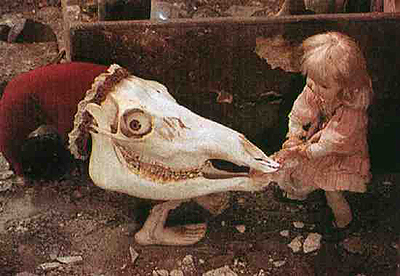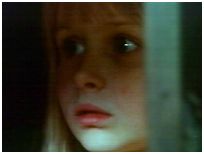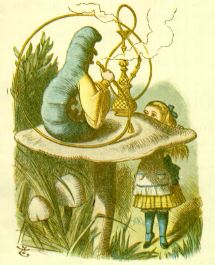Skulduggery and Intrigue in the Museum World
The Zymoglyphic Museum has been targeted by the Museum of Dust for a hostile takeover. We recognize that due to staffing shortages the Zymoglyphic Museum's cleanliness may not be up to snuff (and noting that some staff believe that the accumulated dust enhances, rather than detracts from, the exhibits, by lending them a certain air of authenticity and credbility), and that the museum does indeed have a high concentration of desirable rust and decay, and further that the museum, as with all things, must eventually return to dust. Still, we had not expected it to come so soon. The museum's board is meeting even now to assess the threat.
The facts we have so far are these: The Museum of Dust's director goes by the highly suspicious name of Incognita Nom de Plume, or some variation thereof, and has an implausibly long personal history, involving an arachnoid accomplice (who sounds dangerous) and a mysterious entity called "Musrum" whose museum seems destined to suffer a fate similar to our own. We suspect this cabal may be associated with the equally shadowy Athanasius Kircher "Society", of which Kircher himself is the recording secretary and apparently its only member. Kircher had his own museum in Rome over 300 years ago (reduced to dust by now), and had not been heard from since then until he entered the modern age by becoming, like so many others, a blogger.
We will be sifting through the evidence for further clues.
-- Museum Staff
The facts we have so far are these: The Museum of Dust's director goes by the highly suspicious name of Incognita Nom de Plume, or some variation thereof, and has an implausibly long personal history, involving an arachnoid accomplice (who sounds dangerous) and a mysterious entity called "Musrum" whose museum seems destined to suffer a fate similar to our own. We suspect this cabal may be associated with the equally shadowy Athanasius Kircher "Society", of which Kircher himself is the recording secretary and apparently its only member. Kircher had his own museum in Rome over 300 years ago (reduced to dust by now), and had not been heard from since then until he entered the modern age by becoming, like so many others, a blogger.
We will be sifting through the evidence for further clues.
-- Museum Staff
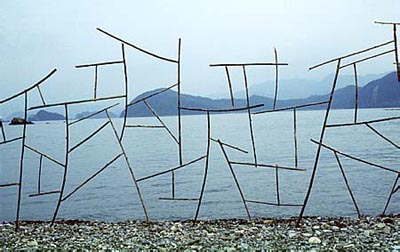 As I noted
As I noted 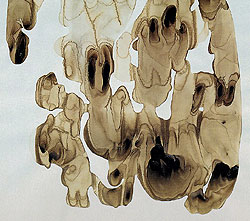 A lesser-known type of work that he does are "snowball paintings", which are created by putting a snowball stained with a natural dye on paper and letting it melt. The result is an amazingly detailed pattern created by the way the dye is deposited as the snow melts and the water evaporates. A detail from one is shown here, with an enlargement
A lesser-known type of work that he does are "snowball paintings", which are created by putting a snowball stained with a natural dye on paper and letting it melt. The result is an amazingly detailed pattern created by the way the dye is deposited as the snow melts and the water evaporates. A detail from one is shown here, with an enlargement 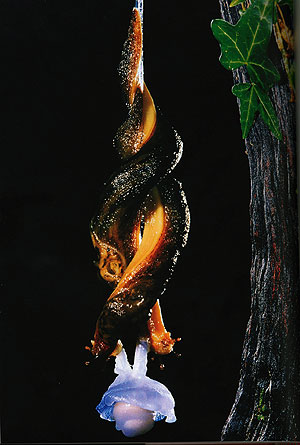
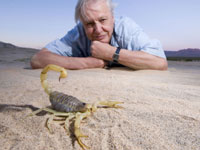 David Attenborough would make an excellent guide to the Zymoglyphic regions as well. He has great qualifications - he had a little museum when he was a boy, and now has huge collection of souvenirs from his travels. He is a perfect mixture of authoritativeness, enthusiasm, wonder, and a taste for the bizarre. A phrase he often uses is "and the strangest of all is this one...". He combines all that with the latest technical wizardry in closeup photography and has an engaging personal style. He is always on the scene, often windblown or out of breath, battling mosquitos to sneak up on some hapless creature. He keeps up with recent discoveries, so each series often includes some new odd animal, plant, or behavior that I have not heard about. He has covered a full range of biological and anthropological themes, and he has managed to contribute to science without having to specialize. He always has interesting ideas on the interconnectedness of things; not just describing some odd behavior, but explaining what forces have caused it to evolve that way. If he is not available for the job (as is likely), he can still serve as a role model!
David Attenborough would make an excellent guide to the Zymoglyphic regions as well. He has great qualifications - he had a little museum when he was a boy, and now has huge collection of souvenirs from his travels. He is a perfect mixture of authoritativeness, enthusiasm, wonder, and a taste for the bizarre. A phrase he often uses is "and the strangest of all is this one...". He combines all that with the latest technical wizardry in closeup photography and has an engaging personal style. He is always on the scene, often windblown or out of breath, battling mosquitos to sneak up on some hapless creature. He keeps up with recent discoveries, so each series often includes some new odd animal, plant, or behavior that I have not heard about. He has covered a full range of biological and anthropological themes, and he has managed to contribute to science without having to specialize. He always has interesting ideas on the interconnectedness of things; not just describing some odd behavior, but explaining what forces have caused it to evolve that way. If he is not available for the job (as is likely), he can still serve as a role model!
